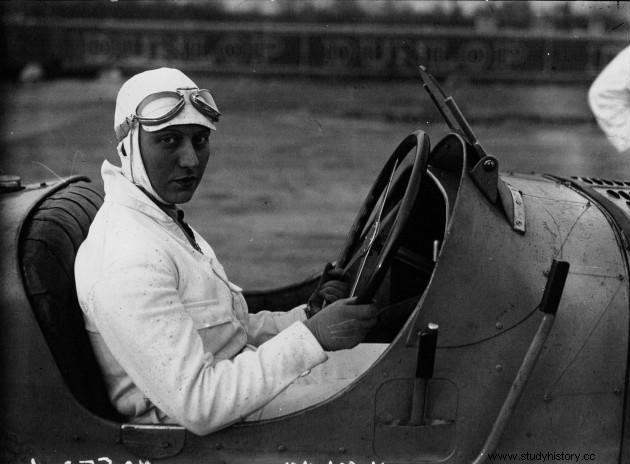Mariette Hélène Delangle, known as Hellé Nice (1900 – 1984) was a dancer and racing driver.
Music hall dancer
 Daughter of Alexandrine Bouillie and Léon Delangle, postman, Mariette Hélène Delangle was born in Aunay-sous-Auneau ( Eure-et-Loir) on December 15, 1900. As a child, she was already passionate about car racing. Her father died when she was four years old and her mother raised her alone with her siblings.
Daughter of Alexandrine Bouillie and Léon Delangle, postman, Mariette Hélène Delangle was born in Aunay-sous-Auneau ( Eure-et-Loir) on December 15, 1900. As a child, she was already passionate about car racing. Her father died when she was four years old and her mother raised her alone with her siblings.
At sixteen, Mariette left her village to go to Paris and work there as a model and as a dancer in music halls. She then took the stage name Hélène Nice (which eventually became Hellé Nice) and gradually established her success, reputation and income. Ten years later, in 1926, she went on tour in Europe.
Accidents
Besides dancing, Hellé Nice enjoys driving and sports cars. With friends, she practiced automobile circuits and experienced the intoxication of speed. In July 1927, one of his friends died while driving during a race and this tragedy devastated him. She who decided to devote herself to dancing rather than driving finds herself unable to go back on stage for several months. However, she returned to the front of the stage at the end of the year, during a show alongside Maurice Chevalier.
In 1929, a skiing accident broke her knee cartilage and her dancing career came to an abrupt end. Hellé Nice then chose to devote himself to professional piloting and began to participate in races. The same year, she won a women's Grand-Prix race at Montlhéry and broke a women's world speed record. Thanks to the notoriety gained, the Bugatti company offers her a vehicle for the next race which she wins again. In 1930, she went on tour in the United States.
Grands Prix and world records
Having become very popular and leading the high life, Hellé Nice openly displays its desire to compete with male drivers. In 1931, the only woman on the Grand Prix circuit, she drove a Bugatti T35C in five major Grand Prix races in France and in the Italian Grand Prix at Monza. She does not win any but deserves her place on the circuit and regularly beats great male drivers. She participated in many parallel races and notably won the Paris – Saint-Raphaël Rally in 1932 and the Ladies' Cup in 1936. The same year, during the São Paulo Grand Prix, when she was in second position, she hits a bale of straw at high speed and loses control of his vehicle. This terrible accident kills four spectators, injures many others and plunges her into a coma for three days. She stayed two months in the hospital but this tragedy haunted her for the rest of her life.
The following year, Hellé Nice took part in the "Yacco" endurance trials for women at the Montlhéry autodrome, driving alternately with three other drivers for ten days and nights. There she beat ten world records that she still holds.
Helle Nice and the Second World War
The Second World War interrupted racing in Europe and Hellé Nice spent those years on the Côte d'Azur. In 1949, during a party organized to celebrate the return of the races, Louis Chiron, champion of Grand Paris, publicly accused him of having been an agent of the Gestapo. No evidence has ever come to support the accusation of Louis Chiron and the official documents in Berlin do not mention links with Hellé Nice, but the accusation marks the end of his career and the abandonment of his sponsors, his friends and her lover.
Indebted and isolated, Hellé Nice spent her last years hiding under a pseudonym and living on the charity of a Parisian organization. His automotive successes are erased from the annals and his popularity soars. Died on 1 st October 1984 in Nice, his cremation was paid for by the same charity organization that came to his aid. His ashes are sent to his sister, but his name is not mentioned on the family memorial at the cemetery.
